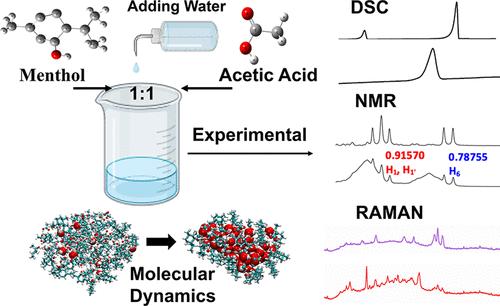当前位置:
X-MOL 学术
›
Ind. Eng. Chem. Res.
›
论文详情
Our official English website, www.x-mol.net, welcomes your
feedback! (Note: you will need to create a separate account there.)
Investigating the Impact of Water on a Menthol-Based Deep Eutectic Solvent: A Combined Experimental and Molecular Dynamics Study
Industrial & Engineering Chemistry Research ( IF 3.8 ) Pub Date : 2024-11-18 , DOI: 10.1021/acs.iecr.4c02346 Oluseyi Olawuyi, Md Basir Bin Rafiq, Sabbir Ahmed, Anusha Bhattarai, Ophelia Adjei-sah, Mahdi Ghasemi, Faiyaz Md Efaz, Abdul Hannan, Carl Jacky Saint-Louis, Mohammad A. Halim
Industrial & Engineering Chemistry Research ( IF 3.8 ) Pub Date : 2024-11-18 , DOI: 10.1021/acs.iecr.4c02346 Oluseyi Olawuyi, Md Basir Bin Rafiq, Sabbir Ahmed, Anusha Bhattarai, Ophelia Adjei-sah, Mahdi Ghasemi, Faiyaz Md Efaz, Abdul Hannan, Carl Jacky Saint-Louis, Mohammad A. Halim

|
Deep eutectic solvents (DESs) have emerged as potential alternatives to traditional solvents, offering unique properties and potential applications. However, the excessively viscous nature of DESs limits their applications in extraction, separation, electrodeposition, battery and energy storage, and drug delivery. The presence of water as a cosolvent can substantially reduce the viscosity and density of DESs and open widespread applications. The aim of this research is to elucidate the nanostructures of DESs in the presence of water, which is key to understanding and tuning their properties for various applications. Multitechnique approaches such as Raman spectroscopy, differential scanning calorimetry (DSC), 1H nuclear magnetic resonance, and an all-atom molecular dynamics (MD) simulation were employed to determine how water affects the molecular-level arrangement, dynamics, and interactions of a L-menthol/acetic acid (AA)-based hydrophobic DES at various hydration levels. A pure DES exhibits significant H-bonding interactions with menthol and AA. As water is added, these interactions weaken, new H-bonding interactions between the DES system and water emerge, and the DES turns into a binary mixture as evident from visual inspection and DSC and Raman experiments. As the contacts between menthol and AA weaken and the number of contacts between water molecules increases, about 50%–60% of water leads to a different system. Additionally, principal component analysis assists us in identifying the sequences in which the characteristics of the DES change with the gradual addition of water. The changes detected in the nanostructural characteristics of the L-menthol/AA DES can aid to develop a less viscous and dense DES suited for special applications. The combined Raman spectroscopic and MD simulation analysis provided deep molecular-level insights into the structural and dynamic changes occurring in the Men–AA system with varying water content. The findings obtained from this research not only enhance our comprehension of the influence of water on altering the characteristics of DES but also facilitate the development of DES systems specifically designed for industrial operations that need reduced viscosity and density.
中文翻译:

研究水对薄荷醇基深共晶溶剂的影响:实验和分子动力学相结合的研究
深共熔溶剂 (DES) 已成为传统溶剂的潜在替代品,具有独特的性能和潜在的应用。然而,DES 的过粘性限制了它们在提取、分离、电沉积、电池和储能以及药物输送方面的应用。水作为助溶剂的存在可以大大降低 DES 的粘度和密度,并开辟了广泛的应用。本研究的目的是阐明 DES 在水存在下的纳米结构,这是理解和调整其各种应用特性的关键。采用拉曼光谱、差示扫描量热法 (DSC)、1H 核磁共振和全原子分子动力学 (MD) 模拟等多种技术方法来确定水如何影响基于薄荷醇/乙酸 (AA) 的疏水性 DES 在各种水合水平下的分子水平排列、动力学和相互作用。纯 DES 与薄荷醇和 AA 表现出显着的 H 键相互作用。随着水的加入,这些相互作用减弱,DES 系统与水之间出现新的 H 键相互作用,DES 变成二元混合物,这从目视检查以及 DSC 和拉曼实验中可以明显看出。随着薄荷醇和 AA 之间的接触减弱,水分子之间的接触数量增加,大约 50%-60% 的水会导致不同的系统。此外,主成分分析有助于我们确定 DES 特性随水的逐渐添加而变化的顺序。在 L-薄荷醇/AA DES 的纳米结构特性中检测到的变化有助于开发适合特殊应用的粘度较低且密度较低的 DES。 拉曼光谱和 MD 模拟分析相结合,为含水量变化的 Men-AA 系统发生的结构和动力学变化提供了深入的分子水平见解。从这项研究中获得的发现不仅增强了我们对水对改变 DES 特性的影响的理解,还促进了专为需要降低粘度和密度的工业操作而设计的 DES 系统的开发。
更新日期:2024-11-19
中文翻译:

研究水对薄荷醇基深共晶溶剂的影响:实验和分子动力学相结合的研究
深共熔溶剂 (DES) 已成为传统溶剂的潜在替代品,具有独特的性能和潜在的应用。然而,DES 的过粘性限制了它们在提取、分离、电沉积、电池和储能以及药物输送方面的应用。水作为助溶剂的存在可以大大降低 DES 的粘度和密度,并开辟了广泛的应用。本研究的目的是阐明 DES 在水存在下的纳米结构,这是理解和调整其各种应用特性的关键。采用拉曼光谱、差示扫描量热法 (DSC)、1H 核磁共振和全原子分子动力学 (MD) 模拟等多种技术方法来确定水如何影响基于薄荷醇/乙酸 (AA) 的疏水性 DES 在各种水合水平下的分子水平排列、动力学和相互作用。纯 DES 与薄荷醇和 AA 表现出显着的 H 键相互作用。随着水的加入,这些相互作用减弱,DES 系统与水之间出现新的 H 键相互作用,DES 变成二元混合物,这从目视检查以及 DSC 和拉曼实验中可以明显看出。随着薄荷醇和 AA 之间的接触减弱,水分子之间的接触数量增加,大约 50%-60% 的水会导致不同的系统。此外,主成分分析有助于我们确定 DES 特性随水的逐渐添加而变化的顺序。在 L-薄荷醇/AA DES 的纳米结构特性中检测到的变化有助于开发适合特殊应用的粘度较低且密度较低的 DES。 拉曼光谱和 MD 模拟分析相结合,为含水量变化的 Men-AA 系统发生的结构和动力学变化提供了深入的分子水平见解。从这项研究中获得的发现不仅增强了我们对水对改变 DES 特性的影响的理解,还促进了专为需要降低粘度和密度的工业操作而设计的 DES 系统的开发。


















































 京公网安备 11010802027423号
京公网安备 11010802027423号